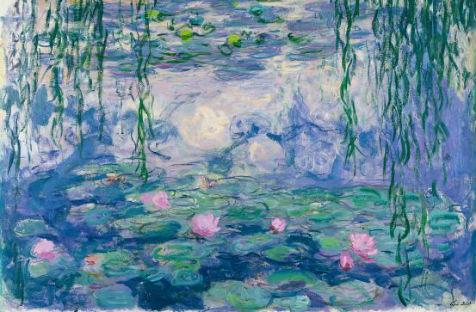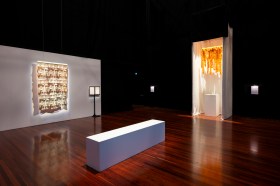The exhibition offers an in depth look at this important artist’s output, in particular it focuses on the paintings executed within his own personal oasis, his garden at Giverny.
This is the largest representation of the Impressionist master ever shown in Australia. Monet’s Garden, the 2013 instalment in the National Gallery of Victoria’s Melbourne Winter Masterpiece series brings together 62 paintings by Claude Monet 50 of which are on loan from the Musée Marmottan Monet in Paris.
The first work in the exhibition Taking a walk near Argenteuil (1875), a bucolic countryside scene, acts as a thematic key to the exhibition. Although Monet’s wife, young son and close friend were the models, the artist was primarily concerned with capturing his experience of the natural world such that their faces are left blank and anonymous. The eye is drawn into the canvas through a swathe of wildflowers carpeting the ground and upwards to a bright expanse of luscious cloudscape. The painting presages the years in Giverny when Monet did away with figures entirely and gave himself over to the observation and rendering of light, water and colour in nature.The holdings of the Musée Marmottan are significant as the works come from Monet’s own personal collection. A donation by his family resulted in the museum becoming the custodian of the world’s largest holding of Monet. Also in the first room Vétheuil in the fog (1879) a painting exhibited numerous times yet Monet never parted with it. This was perhaps due to its less than favourable critical reception. The painting was ahead of it’s time, radical in it’s handling of form depicting only the barest outline of the town within a canvass full of atmospheric layers shrouding its subject. Another painting of Vétheuil comes from the NGV collection and was painted in clearer conditions indicating the beginning of Monet’s practice of returning repeatedly to the same spot to paint at various times of day, as in the famous haystacks series. Monet developed a scientific level of observation and enquiry and his painting shows he strove to achieve a true reflection of how he saw the landscape.
Monet’s various campaigns, his trips throughout France, and also to London and Norway are represented in the second room, showing subjects such as the gothic Rouen Cathedral and the Charing Cross Bridge. It was satisfying to see the NGV’s own Rough weather at Étretat (1883) paired with a contrasting painting of the same scene serenely illuminated in the rosy glow of daybreak.
The importance of Giverny, where Monet lived for over 40 years until his death is the subject of the final two rooms of paintings in the exhibition. A deeply passionate horticulturalist, Monet established the gardens surrounding his home, creating an English style walled garden as well as the famed Japanese style water garden, in order to have the ultimate subject right on his doorstep.
The paintings of flowers in grand scale like Daylilies (1914-17) and Yellow Irises (1924-25) are like portraits due to Monet’s intimate knowledge of his subject. There are also examples of the large-scale canvases produced as studies that culminated in the panoramic Grand Decorations gifted to the state.
The high point of Monet’s artistic output, the paintings of waterlilies and the Japanese bridge form the centerpiece of the show. These paintings have been endlessly reproduced on posters, mugs and greeting cards and as such may have been unjustly reduced in the minds of many to commodities signifying Art with a capital A. But encountering the actual works in the context of this chronology of the artist’s evolution is a tour de force from this master of colour relationships, unconventional uses of perspective and formal experimentation.
The bridge over the waterlily pond (1900) luxuriously depicts willows, waterlilies and irises edging the banks of the pond where Monet built his green bridge in homage to Japanese artists whose woodblock prints he collected. Shadow and light and vivid colour draw the viewer in until the riotous brushstrokes and delicate transparencies disintegrate into near abstraction.
The meditative waterlily series, which Monet called ‘waterscapes’, is lusciously painted and consistently innovative. The layering of blue, mauve and green tones in depictions of the pond are accented by the luminous blooms that Monet imported in an exotic array of colours. Monet was an expert at painting water and the effects of light on its surface, and yet he reminds viewers that they are looking at paint by sometimes leaving the edges of the canvas unpainted.
The grouping of a trio of waterlilies from 1907 shows the same passage of the pond at different times of day, the soft greens and lilacs of dawn and the fiery orange tones of sunset as well as an unfinished study that shows the artist’s working methods. The composition provides a sense of hovering over the pond as there is anchoring shoreline or horizon; there is only water and clusters of waterlilies that shimmer on the canvas. In the aqueous world of the pond a reflection of open sky pours through the middle of the deep shadows cast by trees above. The effect is at once immersive and expansive.
The final paintings are from Monet’s late works as his eyesight began to fail and he had numerous operations to remove cataracts that had affected his eyesight and colour register. Paint is applied unmixed in rapidly gestural brushstrokes as the house, and the Japanese drum bridge disappear into the garden completely. Monet’s practice has been linked to the later movement of abstract expressionism and the visual clues are apparent here. But, abstraction was never an intellectual goal for the artist; instead as it always had been, his intense desire to represent his visual experience through painting was what drove him.
There is enduring beauty to be found in Monet’s Garden and the opportunity to examine the evolving practice of this principal figure, something unlikely to be repeated on our shores for a many years.
Rating: four and a half stars
Monet’s Garden: The Musée Marmottan Monet, Paris
10 May 2013 – 08 Sep 2013
NGV International, 180 St Kilda Road





